Overview
Bots are conversational apps that a user can send and/or receive messages to/from the bot.
- index.ts: The TypeScript code that listens to the incoming requests. Using Bot Builder and Express.JS
- bot.ts: Sends a message to Voiceflow using the Dialog Manager API.
- teams-app: Manifest package to be installed in Teams client.
- http-client.ts: Abstract Class that has the common methods of the HTTP Client.
- dialog-manager-api.ts: Class that extends the abstract class explained above and adds all the methods required to interact with the Dialog Manager API.
See the instruction below to see how you can create your chatbot package using App Studio
Microsoft Teams: App Configuration
Here's the step-by-step how to set up the chatbot and install it on Teams.
Creating App Manifest with App Studio
App Details
Open App Studio in the Teams client.
Click Create a new app and fill out all the required fields including the Bot names, descriptions, etc.
Generate an App ID.

In the App URLs section, include your privacy and TOU webpages. In this example, I am using the placeholder URL, {% c-line %}https://example.com{% c-line-end %}.
Bots config
From the left menu, select Capabilities > Bots.
Then, click Set up to configure a new bot. Fill out the bot name, and let's select the Personal scope for now.
Next, click Generate new password. At the prompt, copy the password. You will need to paste it in your .env file in the next step.
App Credentials
Copy the ID under your bot name (something looks like {% c-line %}123xx567-123x-...{% c-line-end %}) and paste it as an environment variable in your {% c-line %}.env{% c-line-end %} file.
Under App Passwords, generate a new password, and copy it. Then paste it in your {% c-line %}.env{% c-line-end %} file.
These credentials are used to initialize your bot adapter. (See index.ts).
For Messaging Endpoint, we will use ngrok. The URL should be something like: {% c-line %}https://<id>.ngrok.io/api/messages{% c-line-end %}.
Finish creating the app manifest package
Go to Finish > Test and distribute.

If you get any errors, you'll need to fix it. Otherwise, click Install.
You can also download the zip file that contains {% c-line %}manifest.json{% c-line-end %}, and two icon images to install later or distribute.
Voiceflow Configuration
NOTE: Before we continue, it's important we create a general project on Voiceflow.
Let's create the Voiceflow client to work with Voiceflow's cloud using its Dialog Manager API:
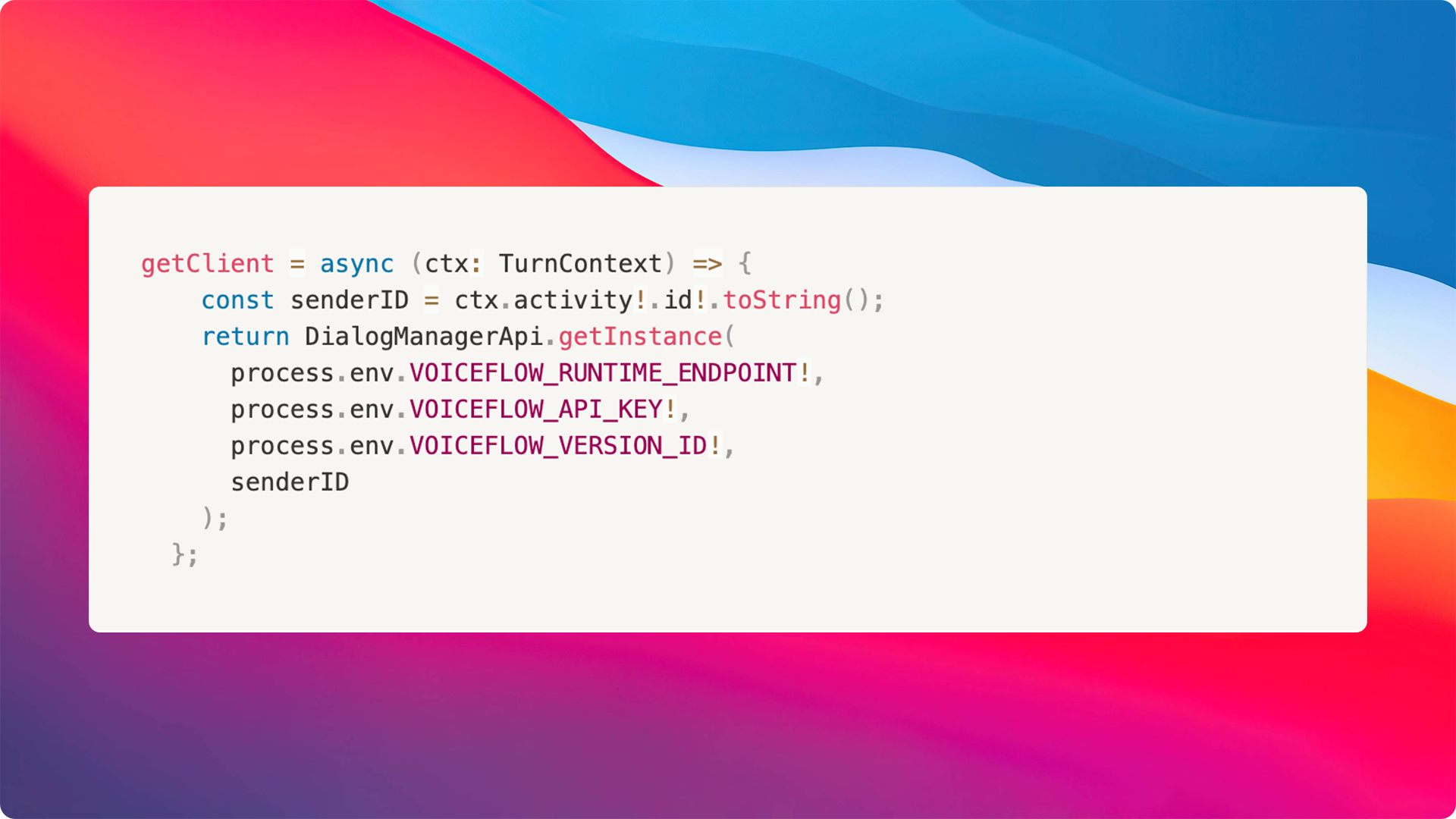
The {% c-line %}getclient(){% c-line-end %} function calls the {% c-line %}DialogManagerApi{% c-line-end %} This is the initialization of the API client.
As you can see, there are some values that will be added to our {% c-line %}.env file{% c-line-end %}. Let's explain how to obtain these variables.
1. VersionID
To obtain your VersionID, you have to go to your Voiceflow Project:

Then copy the {% c-line %}VERSION_ID{% c-line-end %} from the URL in your address bar. When you are inside a Voiceflow project, your address bar should have a URL: {% c-line %}https://creator.voiceflow.com/project/{VERSION_ID}/...{% c-line-end %}
2. apiKey
To obtain the API Key, we need to go to our workspace where we created our General Project. After this, go to the settings of this workspace and click on the developer tab:
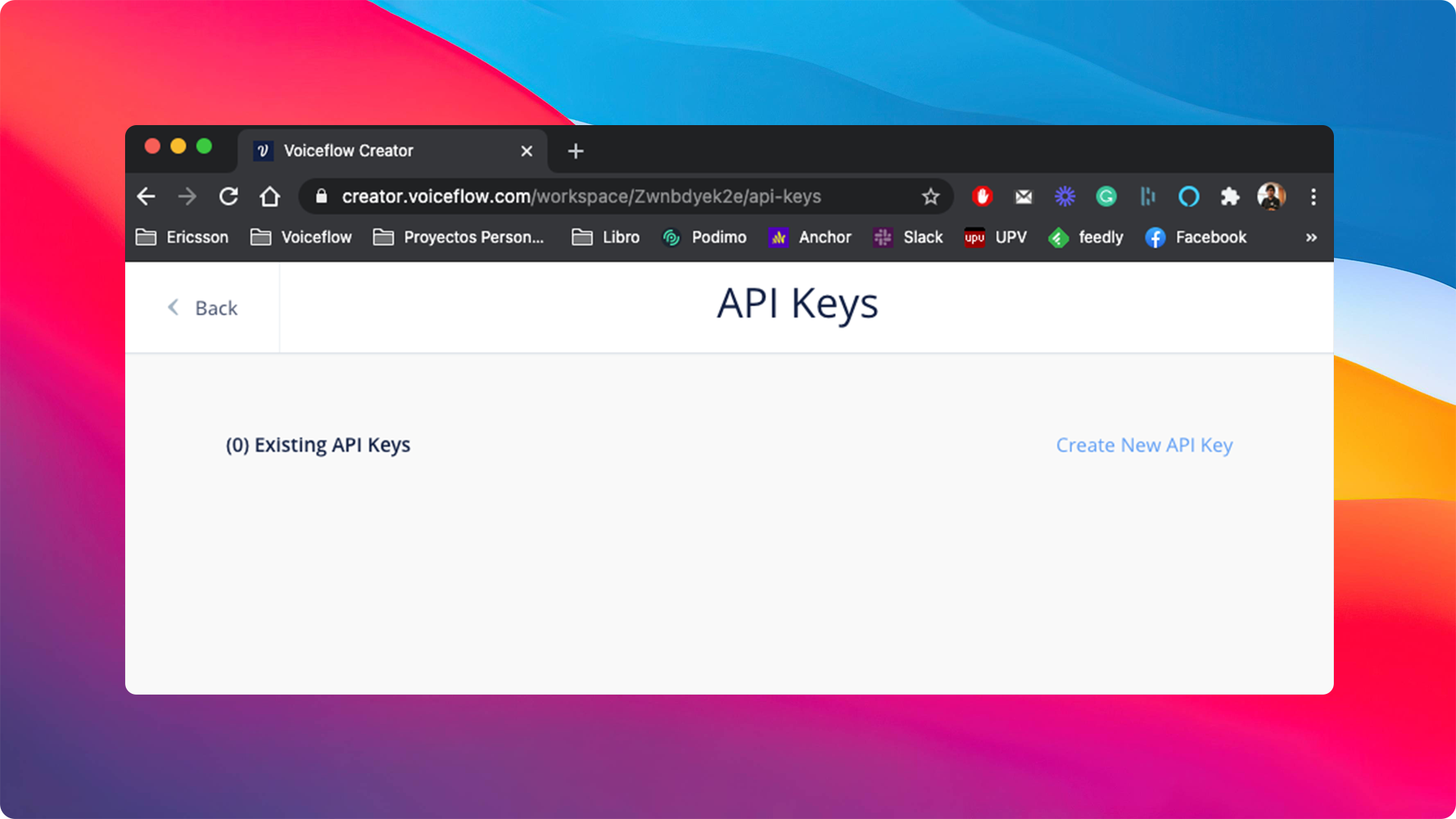
Next, click the {% c-line %}Create new API Key{% c-line-end %} button to create a new one:
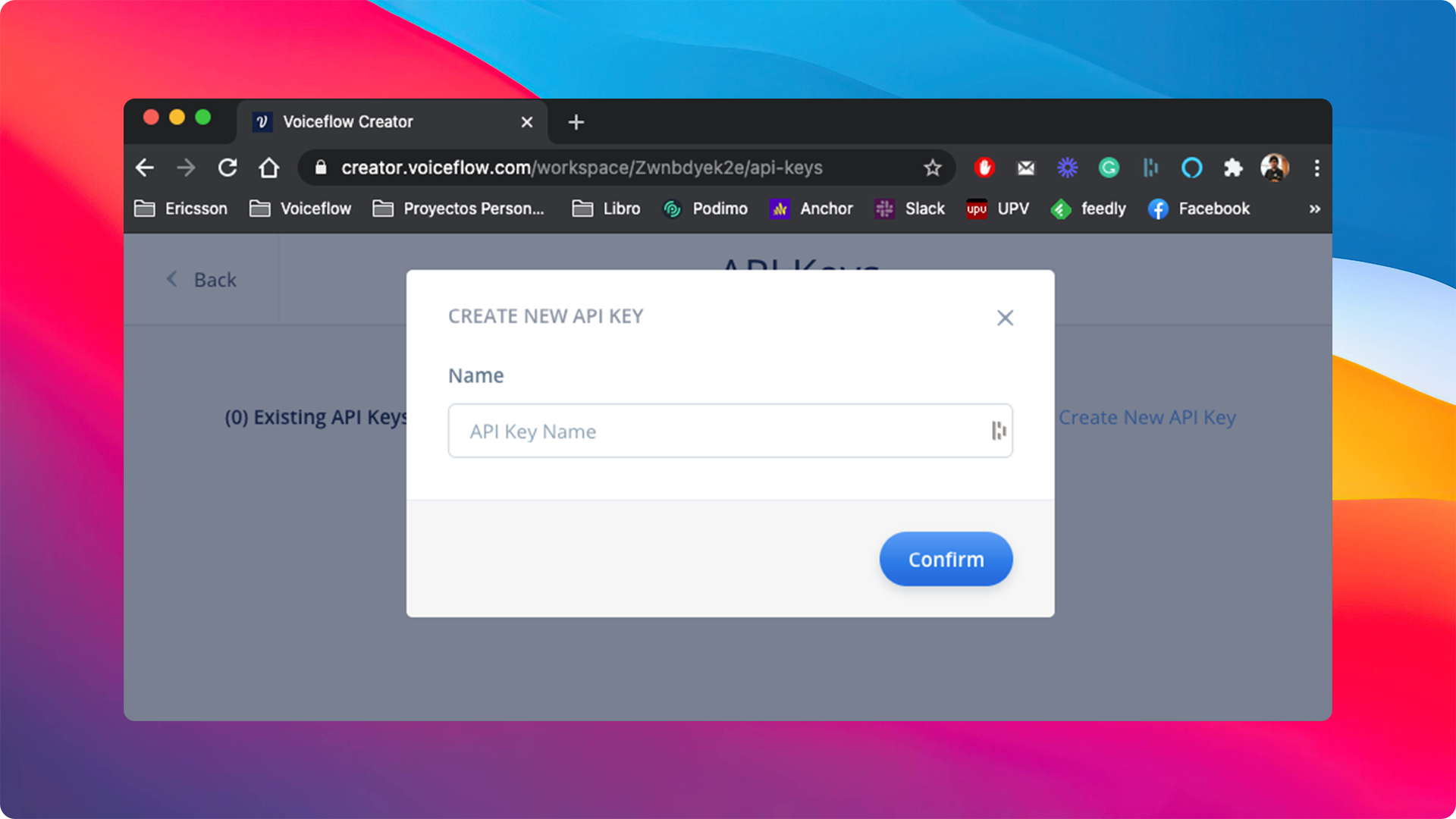
You'll need to add a name for the new API Key, for example, {% c-line %}ms-teams-bot{% c-line-end %}. Once this is completed, we can click the {% c-line %}Confirm button{% c-line-end %}:
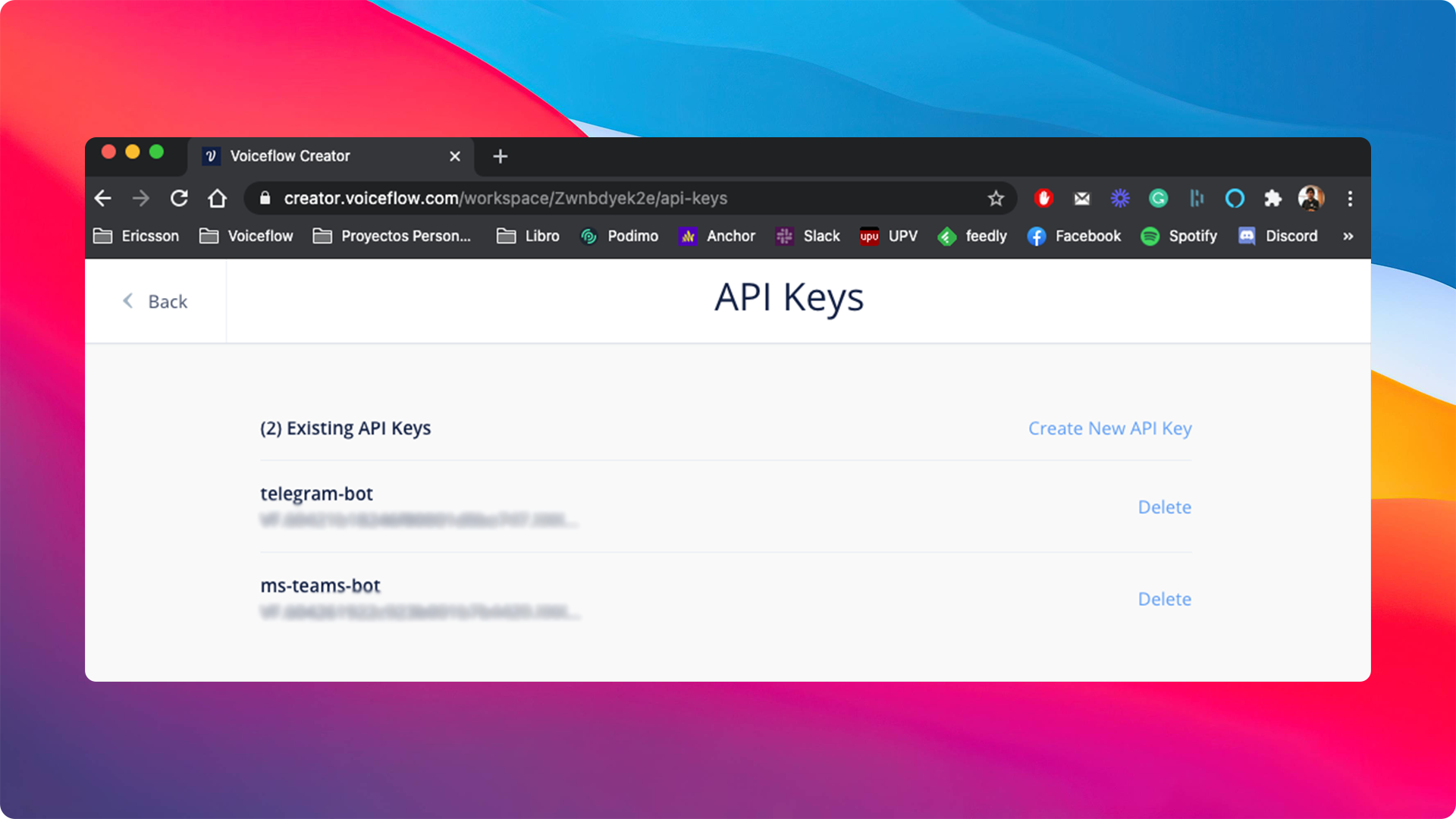
Finally, we have to add these variables to our final {% c-line %}.env{% c-line-end %} file. It should look like this:
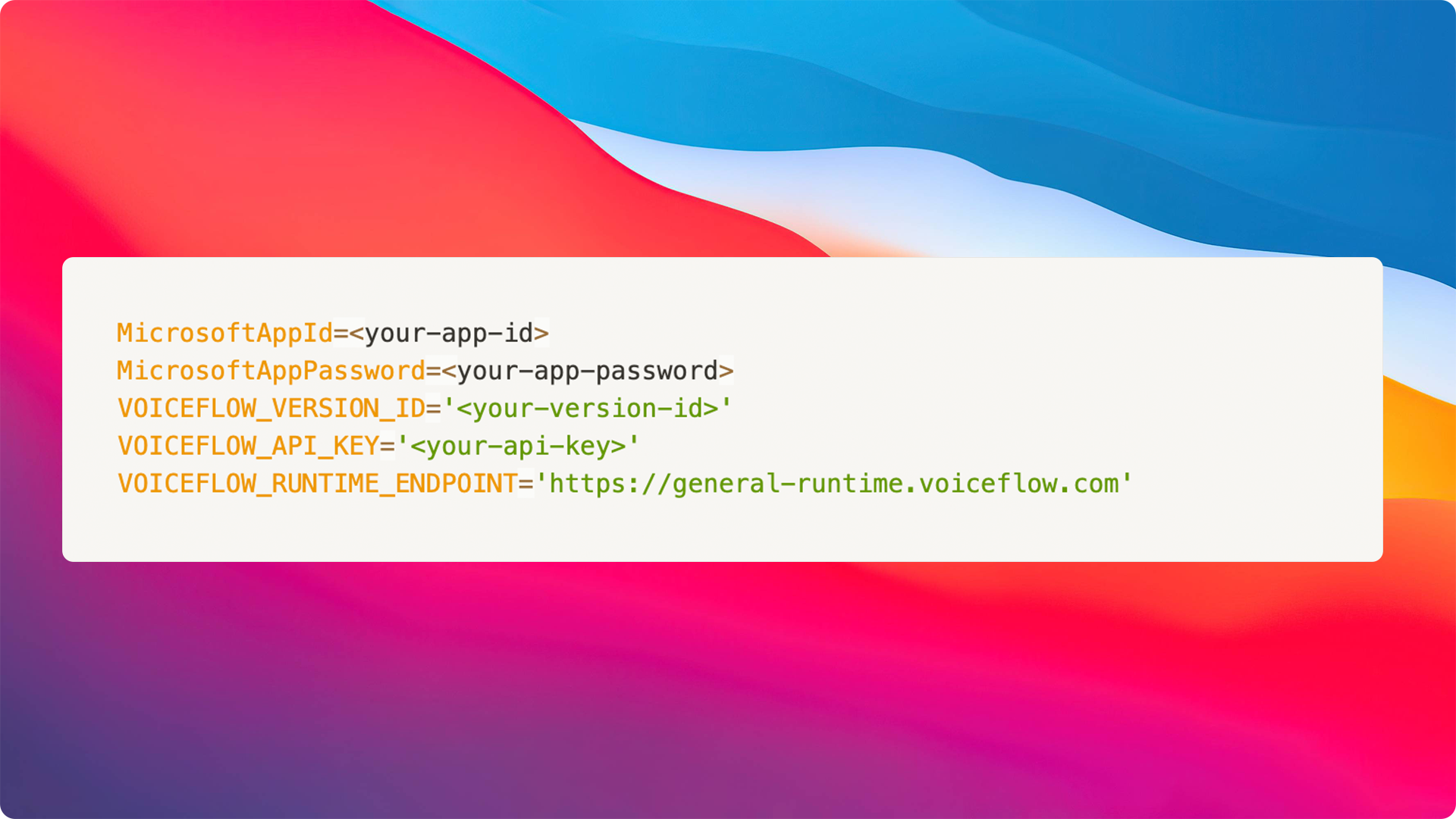
Test your bot
In your Microsoft Teams client, we can now try out our personal bot. You can access the bot you installed from the sidebar on your left.
Now you have a 1:1 chat interface with the bot. Let's type sending a message.

Deployment
Please note: Ngrock is a great tool; however, this does not work for production environments.
To deploy your chatbot, view the following: Deploy your bot to Azure.
Resources
- Official Bot Builder Documentation - The Official Bot Builder Documentation
- Official Voiceflow's Dialog Manager API Documentation - Official Voiceflow's Dialog Manager API Documentation
- ⚙️ To access all of the code mentioned above, click here.
Conclusion
And so with less than 200 lines of code we now have a Microsoft Teams bot connected to Voiceflow. I hope this gives you a better understanding of the how you can use Voicefow to bring conversational experiences into your very own interfaces and products. Happy coding!
Overview
Bots are conversational apps that a user can send and/or receive messages to/from the bot.
- index.ts: The TypeScript code that listens to the incoming requests. Using Bot Builder and Express.JS
- bot.ts: Sends a message to Voiceflow using the Dialog Manager API.
- teams-app: Manifest package to be installed in Teams client.
- http-client.ts: Abstract Class that has the common methods of the HTTP Client.
- dialog-manager-api.ts: Class that extends the abstract class explained above and adds all the methods required to interact with the Dialog Manager API.
See the instruction below to see how you can create your chatbot package using App Studio
Microsoft Teams: App Configuration
Here's the step-by-step how to set up the chatbot and install it on Teams.
Creating App Manifest with App Studio
App Details
Open App Studio in the Teams client.
Click Create a new app and fill out all the required fields including the Bot names, descriptions, etc.
Generate an App ID.

In the App URLs section, include your privacy and TOU webpages. In this example, I am using the placeholder URL, {% c-line %}https://example.com{% c-line-end %}.
Bots config
From the left menu, select Capabilities > Bots.
Then, click Set up to configure a new bot. Fill out the bot name, and let's select the Personal scope for now.
Next, click Generate new password. At the prompt, copy the password. You will need to paste it in your .env file in the next step.
App Credentials
Copy the ID under your bot name (something looks like {% c-line %}123xx567-123x-...{% c-line-end %}) and paste it as an environment variable in your {% c-line %}.env{% c-line-end %} file.
Under App Passwords, generate a new password, and copy it. Then paste it in your {% c-line %}.env{% c-line-end %} file.
These credentials are used to initialize your bot adapter. (See index.ts).
For Messaging Endpoint, we will use ngrok. The URL should be something like: {% c-line %}https://<id>.ngrok.io/api/messages{% c-line-end %}.
Finish creating the app manifest package
Go to Finish > Test and distribute.

If you get any errors, you'll need to fix it. Otherwise, click Install.
You can also download the zip file that contains {% c-line %}manifest.json{% c-line-end %}, and two icon images to install later or distribute.
Voiceflow Configuration
NOTE: Before we continue, it's important we create a general project on Voiceflow.
Let's create the Voiceflow client to work with Voiceflow's cloud using its Dialog Manager API:

The {% c-line %}getclient(){% c-line-end %} function calls the {% c-line %}DialogManagerApi{% c-line-end %} This is the initialization of the API client.
As you can see, there are some values that will be added to our {% c-line %}.env file{% c-line-end %}. Let's explain how to obtain these variables.
1. VersionID
To obtain your VersionID, you have to go to your Voiceflow Project:

Then copy the {% c-line %}VERSION_ID{% c-line-end %} from the URL in your address bar. When you are inside a Voiceflow project, your address bar should have a URL: {% c-line %}https://creator.voiceflow.com/project/{VERSION_ID}/...{% c-line-end %}
2. apiKey
To obtain the API Key, we need to go to our workspace where we created our General Project. After this, go to the settings of this workspace and click on the developer tab:

Next, click the {% c-line %}Create new API Key{% c-line-end %} button to create a new one:

You'll need to add a name for the new API Key, for example, {% c-line %}ms-teams-bot{% c-line-end %}. Once this is completed, we can click the {% c-line %}Confirm button{% c-line-end %}:

Finally, we have to add these variables to our final {% c-line %}.env{% c-line-end %} file. It should look like this:

Test your bot
In your Microsoft Teams client, we can now try out our personal bot. You can access the bot you installed from the sidebar on your left.
Now you have a 1:1 chat interface with the bot. Let's type sending a message.

Deployment
Please note: Ngrock is a great tool; however, this does not work for production environments.
To deploy your chatbot, view the following: Deploy your bot to Azure.
Resources
- Official Bot Builder Documentation - The Official Bot Builder Documentation
- Official Voiceflow's Dialog Manager API Documentation - Official Voiceflow's Dialog Manager API Documentation
- ⚙️ To access all of the code mentioned above, click here.
Conclusion
And so with less than 200 lines of code we now have a Microsoft Teams bot connected to Voiceflow. I hope this gives you a better understanding of the how you can use Voicefow to bring conversational experiences into your very own interfaces and products. Happy coding!




.png)
.jpeg)
.svg)